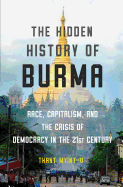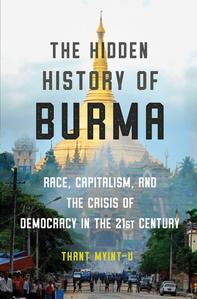
 The Hidden History of Burma is a work of history and contemporary political analysis, an explanation of how the promise of Burmese political reform was eclipsed by ethnic violence and uncertainty. Thant Myint-U refers to the country as Burma throughout, despite the ruling junta's 1989 decision to change the country name in English to Myanmar, for linguistic reasons as well as "the nativist underpinnings of the name change." This introduces a common theme of the book: Burma as a country in flux, unsure about its identity. Former UN diplomat Thant Myint-U shows how matters of identity are tied to some of the country's challenges today.
The Hidden History of Burma is a work of history and contemporary political analysis, an explanation of how the promise of Burmese political reform was eclipsed by ethnic violence and uncertainty. Thant Myint-U refers to the country as Burma throughout, despite the ruling junta's 1989 decision to change the country name in English to Myanmar, for linguistic reasons as well as "the nativist underpinnings of the name change." This introduces a common theme of the book: Burma as a country in flux, unsure about its identity. Former UN diplomat Thant Myint-U shows how matters of identity are tied to some of the country's challenges today.
Thant Myint-U has written on Burmese history before in books like The Making of Modern Burma. The Hidden History of Burma introduces readers to the basics of Burmese history, focusing particularly on the way colonialism and migration contributed to a country riven by countless ethnic groups with separatist ambitions. Media attention has focused on the plight of the largely Muslim Rohingya people, but Thant Myint-U shows how Burma's unstable mix of ethnicities, ideologies and religions made the country "a sea of rebels and bandits" after the nation's independence from Britain in 1948. When the prospect of reform prompted many well-meaning nations and international organizations to engage with the long-isolated country, they often stumbled into a situation they didn't fully understand.
Thant Myint-U's grandfather U Thant was Secretary-General of the United Nations from 1961 to 1971, seen by many as "a symbol of a different, more liberal Burma." When Burmese military rule started to give way to something closer to democracy, Thant Myint-U worked with the ex-generals. The book frequently serves as a frontline account of events, featuring personal insight into many of the key figures in the transition, and insider accounts of the painstaking, frustrating work of diplomacy as well as agonizing examples of missed opportunities. By immersing the reader in the difficulties of, for example, organizing disaster relief with a sclerotic government, Thant Myint-U hints at how even a mythologized figure like Nobel Laureate Aung San Suu Kyi could not produce the miraculous change international observers hoped for.
The book contains many strong opinions about how Burmese reforms came to stall and give way to the violence that created hundreds of thousands of Rohingya refugees. His critiques are levelled at Burmese political leaders and the international community, who Thant Myint-U depicts as overly credulous of Burma's reforms. He also criticizes the harshness and futility of international sanctions, which did not bring political change but did contribute to Burma's desperate poverty. The Hidden History of Burma shows that reforms often fixed the easiest of Burma's problems, doing nothing to address the country's more fundamental challenges.
For Western observers who may have seen the crackdown on the Rohingya as a shocking reversal of recent trends, this book is a sobering corrective, an account of how the nation arrived at a crisis point and how the international community embraced a hopeful, misleading narrative. --Hank Stephenson, manuscript reader, the Sun magazine
Shelf Talker: The Hidden History of Burma explains how a country hailed for seemingly miraculous political reforms gave way to ethnic nationalism and created one of the largest refugee crises in the world.

